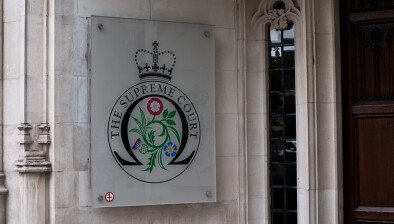NI High Court: Belfast journalist fails in bid to reveal the name of Brexit Protocol challenger

Northern Ireland’s High Court has upheld an anonymity order where there were allegations that the shield was being used to advance Sinn Féin’s political aims.

About this case:
- Citation:[2022] NIQB 16
- Judgment:
- Court:High Court
- Judge:Mr Justice Adrian Colton
The court found that the possible threat of violence to the applicant, should his name be revealed, was sufficient to surmount the ECHR Article 2 requirements.
Background
The applicant, JR 181(3), sought to judicially review a decision of the minister for the Department for Agriculture, Environment and Rural Affairs. That related to a decision to “unilaterally order his officials to halt works related to the construction of inspection facilities for post-Brexit checks on agri-food goods arriving from Britain and to stop further recruitment of inspection staff”.
The applicant further challenged a decision of the minister to instruct officials to halt all checks at ports in Northern Ireland that were not in place from 31 December 2020, which related to the implementation of the Protocol under the Withdrawal Agreement legislation.
Mr Justice David Scoffield initially granted leave to the applicant on various grounds, and was persuaded to anonymise the applicant in the proceedings. The proceedings were halted, and ultimately handed to Mr Justice Adrian Colton, who similarly granted the applicant anonymity.
On 14 February 2022 the Lady Chief Justice’s Office received an email from Adam Kula, a journalist from the News Letter with the following inquiry: “Can you say what the basis was for Mr Justice Colton granting anonymity to the SF member taking the judicial review proceedings over the Irish Sea Border (at a hearing on Feb 4 at the High Court)?”
Mr Kula noted:
“Have members of the press made representations against the anonymity order?
If not, I would like to make one. Apparently the anonymous applicant is a Sinn Fein member. My guess is that they have been granted anonymity on the basis that they fear being targeted for their republicanism…
Someone bringing a challenge on a matter of such seismic import surely should face a rather strong presumption against anonymity, on the basis that it would be rather important for major decisions affecting the political integrity of the UK to be taken at the behest of some anonymous cipher.
This is surely doubly so when that person is a member of Sinn Fein – a political party which very much has ‘skin in the game’ when it comes to the political battle over the protocol…
Lastly, the whole issue of anonymity for loyalists/republican political supporters was surely dealt with by way of legislation some years ago, when the government opted to repeal laws barring political donors from being named. If it is proper to name a financial benefactor of Sinn Fein, why not someone who is driving forward a politically-contentious court case which aligns with the objectives of their party.”
The applicant’s evidence
Despite the above claims, in assessing the anonymity order the court focused primarily on the reasons for anonymity, which had been laid out in the original claim, before such anonymity was challenged.
JR 181(3)’s central case was that he was a 70-year-old man living alone, who had previously received death threats, and feared similar action if his name were to appear in the course of the proceedings:
“I was previously the recipient of death threats in the 1990s and 2000s … from the orange volunteers. I was notified of this by the police.
The Northern Ireland Office previously provided me with a security grant to bulletproof my homes and to put in CCTV due to the threats made to me by loyalists.
Whilst I am a member of Sinn Fein, I am not an elected representative and never have been. My interest in politics is one of the reasons that I appreciate and understand the significance and importance of this case, but I do not see this case in any way as a political one – it is a legal one and one of the utmost importance.”
Mr Kula opined instead that the applicant’s reference to potential violence was “overcooked”. His objection suggested that the applicant was somehow a proxy for Sinn Féin and that it would be wrong for this to be done under the cloak of anonymity.
The court’s consideration
The starting point for the court was the principle of open justice, which states that parties in legal proceedings should be named and known to the public. Any derogation from this stance must be strictly justified and necessary.
The applicant sought to rely on his right to life protected by Article 2 of the ECHR. The test for this was whether or not the public authority (the court) knew of a real and immediate risk to the life of the person concerned.
In assessing this risk, the court looked to the judgment in the Northern Ireland Court of Appeal in Re C & Ors [2012] NICA 47. There, the court contrasted a real risk to a person’s life with a risk that is merely fanciful or remote.
Further, the court noted that applicants had previously been granted anonymity in Brexit-related applications, such as in JR 83, where the High Court granted anonymity to an applicant who sought to challenge the UK government’s decision to introduce the UK withdrawal legislation. That matter went to the Court of Appeal without any interference with the anonymity order.
It seemed to the court that there was no doubt that if the application for a reporting restriction was refused, it would also have the effect of frustrating the order made by Mr Justice Scoffield.
In any event, the court was again satisfied that, on the applicant’s evidence, if he were to be named there would be a real risk of him being exposed to violence, threats of violence and other criminal acts.
Conclusion
The court was satisfied that the risk was a real one, not “fanciful or remote”, and it was immediate in the sense that it was present and continuing, as the controversy relating to the Protocol rages on.
That risk was also seen in the context of the applicant’s individual circumstances. He was someone who had been targeted by loyalist paramilitaries in the past and his fears that such targeting might continue were real.
The reporting restriction imposed was found to be the least restrictive means of avoiding the risk which had been identified to the applicant.









